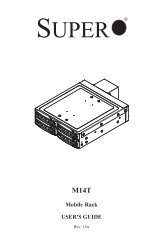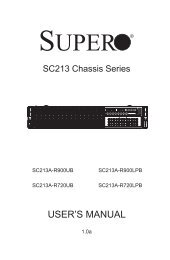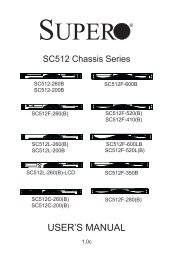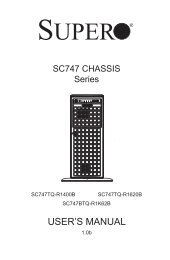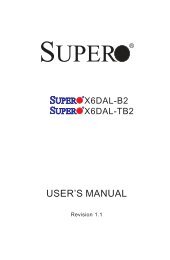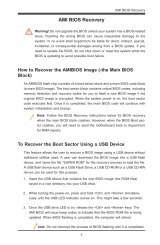X9DR3_i-LN4F+ 1.1.indb - Supermicro
X9DR3_i-LN4F+ 1.1.indb - Supermicro
X9DR3_i-LN4F+ 1.1.indb - Supermicro
Create successful ePaper yourself
Turn your PDF publications into a flip-book with our unique Google optimized e-Paper software.
<strong>X9DR3</strong>-<strong>LN4F+</strong>/X9DRi-<strong>LN4F+</strong> Motherboard User’s Manual<br />
to make sure that the CPU and System temperatures are within the normal<br />
range. Also check the front panel Overheat LED, and make sure that the<br />
Overheat LED is not on.<br />
5. Adequate power supply: Make sure that the power supply provides adequate<br />
power to the system. Make sure that all power connectors are connected.<br />
Please refer to our website for more information on minimum power requirement.<br />
6. Proper software support: Make sure that the correct disk drivers are used.<br />
B. The system becomes unstable before or during OS installation<br />
When the system becomes unstable before or during OS installation, check the<br />
following:<br />
1. Source of installation: Make sure that the devices used for installation are<br />
working properly, including boot devices such as CD/DVD disc, CD/DVD-<br />
ROM.<br />
2. Cable connection: Check to make sure that all cables are connected and<br />
working properly.<br />
3. Using minimum configuration for troubleshooting: Remove all unnecessary<br />
components (-starting with add-on cards first), and use minimum configuration<br />
(with a CPU and a memory module installed) to identify the problematic<br />
areas. Refer to the steps listed in Section A above for proper troubleshooting<br />
procedures.<br />
4. Identifying bad components by isolating them: If necessary, remove a component<br />
in question from the chassis, and test it in isolation to make sure that it<br />
works properly. Replace a bad component with a good one.<br />
5. Check and change one component at a time instead of changing several<br />
items at the same time. This will help isolate and identify the problem.<br />
6. To find out if a component is good, swap the component with a new one to<br />
see if the system will work properly. If so, then the old component is bad.<br />
You can also install the component in question in another system. If the new<br />
system works, the component is good and the old system has problems.<br />
3-4




